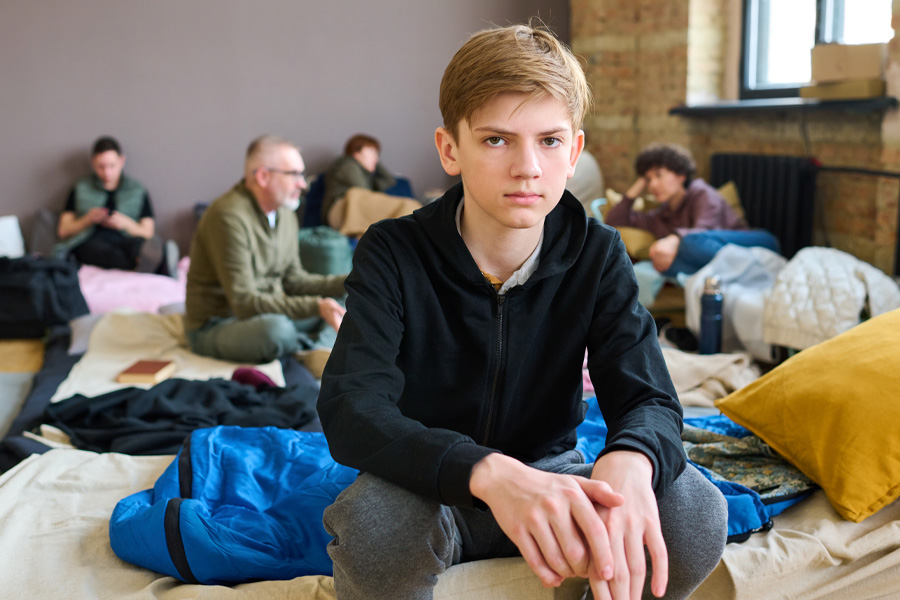
Youth Homelessness

It is no secret or shock to many that the past few years have changed each of our lives to some capacity. Social distancing, school shutdowns, mask mandates, and the list goes on. As we returned to what we may see as “normalcy,” we have started to see a rise in homelessness in not only Charlotte, but also throughout the country, especially amongst adolescents and their families. This raises the question of how homelessness is defined, what are some of the major factors that contribute to adolescent homelessness, what are some of the statistics we are seeing in Charlotte, and available resources. Our Chief Psychologist, Dr. Jennifer Thomas, helps to answer these important questions.
How is homelessness defined?
Definitions of homelessness vary, often depending on various agencies and funding sources used to support programs and resources. The definition of homelessness generally includes emergency shelters, transitional housing, or unsheltered locations. For those youth who are unaccompanied by families or caregivers, the Runaway and Homeless Youth Act defines youth homelessness as “young people who cannot live in a safe environment with a relative and who have no other safe living arrangement.” Other federal definitions of homelessness include “lacking a fixed, regular, and adequate nighttime residence.” Youth homelessness may also include living “doubled up” with other families; couch surfing or staying with friends or relatives; living in hotels or motels; being abandoned in hospitals; awaiting foster care placement; or sleeping in an unsheltered location (e.g., cars, parks, campgrounds, temporary trailers, or abandoned buildings). Notably, many homeless shelters do not accept unaccompanied minors.
Is homelessness on the rise, lowering, or remaining the same for adolescents in Charlotte?
According to the 2022 Charlotte-Mecklenburg State of Housing Instability & Homelessness Report, there were 3,260 people in Mecklenburg County experiencing homelessness (in shelters and unsheltered locations) in October 2022, reflecting an overall 3% increase in homelessness in the past year. This count of individuals experiencing homelessness included 364 families and 127 unaccompanied youth (ages 18-24) but is likely an underestimate given the challenges of identifying all unsheltered locations where individuals may live. Issues with the availability of affordable housing is identified as a significant factor contributing to the increase in homelessness. Notably, minor children ages 0-17 accounted for nearly 25% of the overall number of individuals experiencing homelessness.
During the 2021-2022 school year, 40% more students in Charlotte-Mecklenburg Schools (CMS) were identified as eligible for McKinney-Vento than in 2020-2021, with a total of 4,206 living in doubled up situations in 2021-2022. The McKinney-Vento Homeless Assistance Act (MVA) provides school access and support for academic success for students experiencing homelessness and housing instability.
What are some of the major factors that contribute to adolescent homelessness?
According to a national survey on unaccompanied youth homelessness in America, results show that one in 10 young adults ages 18-25 (an estimated 3.5 million) and at least one in 30 adolescents ages 13-17 (an estimated 700,000) experience homelessness unaccompanied by a parent or guardian over the course of a year (Missed Opportunities: Youth Homelessness in America, National Estimates, 2017). Poverty is a contributing factor to homelessness, and youth with lower household incomes were more likely to experience homelessness. Young parents had three times the risk of experiencing homelessness when compared to non-parenting peers. Young adults without a high school diploma or GED had 4.5 times the risk of experiencing homelessness compared to peers who completed high school. Youth of color and youth who identify as LGBTQ disproportionately experience homelessness and housing instability at higher rates. According to the 2021 National Survey on LGBTQ Youth Mental Health, 28% of LGBTQ youth reported experiencing homelessness or housing instability during their lifetime with many reporting being mistreated or kicked out due to their identity. Family conflict is often indicated as a reason youth give for their homelessness or running away.
What are the common struggles of adolescents who are identified as being homeless?
Youth experiencing unstable housing face higher risks for poor physical and behavioral health outcomes (McKinnon, et al., 2023). Periods of unstable housing might serve as barriers to accessing consistent, comprehensive physical and behavioral health care and may contribute to health challenges resulting from inadequate nutrition and food insecurity. Homelessness also can impact education, sense of safety, and overall development (American Psychological Association, 2022). Students experiencing homelessness are more than twice as likely to be chronically absent, more likely to change schools multiple times, to be suspended, have lower test scores, and have increased risk for dropping out than their peers experiencing housing stability. They also may have limited support systems, be more likely to experience adverse childhood events (ACEs), family rejection, and family instability.
National results from the 2021 Youth Risk Behavior Survey indicated that 2.7% of US high school students experienced unstable housing (McKinnon, et al., 2023). Students experiencing unstable housing were more likely to engage in sexual risks behaviors, substance use, suicidal ideation and attempts, and to experience violence and victimization (McKinnon, et al., 2023; Smith-Grant et al., 2022). Alcohol and other substance use are 2-3 times more prevalent, and the prevalence of depressive symptoms is significantly higher among youth experiencing homelessness.
What are some resources that adolescents can use if they are experiencing homelessness?
The following programs focus on providing education, awareness, and support for local and national
initiatives that provide resources and work towards ending youth homelessness:
For information on McKinney-Vento Program services for CMS students, visit https://www.cmsk12.org/Page/9726.
The Family and Youth Services Bureau (FYSB) funds the National Runaway Safeline which includes a crisis hotline (1-800-RUNAWAY) and online services 24/7.
Locally, youth can contact The Relatives youth crisis center at 704-377-0602 for help with finding shelter and support.


